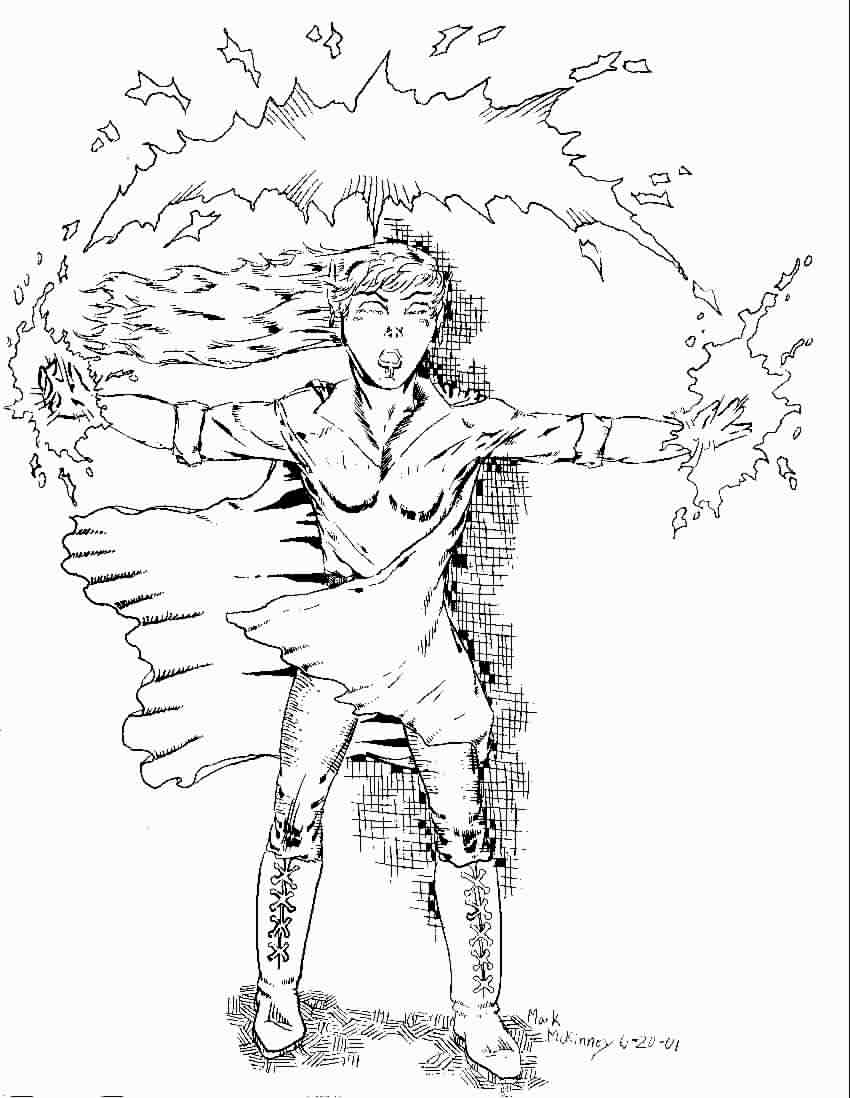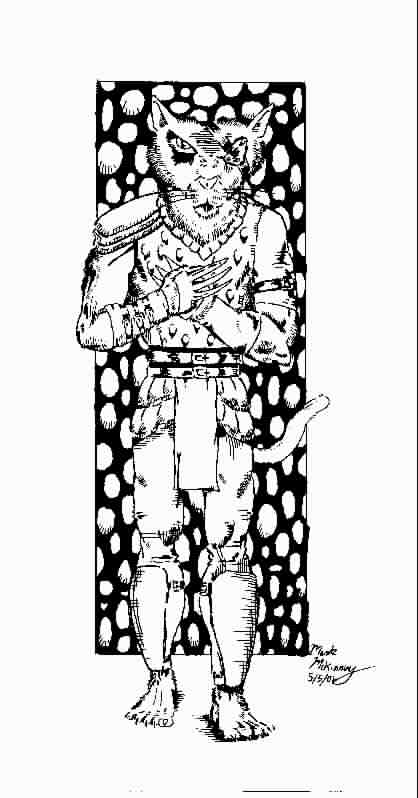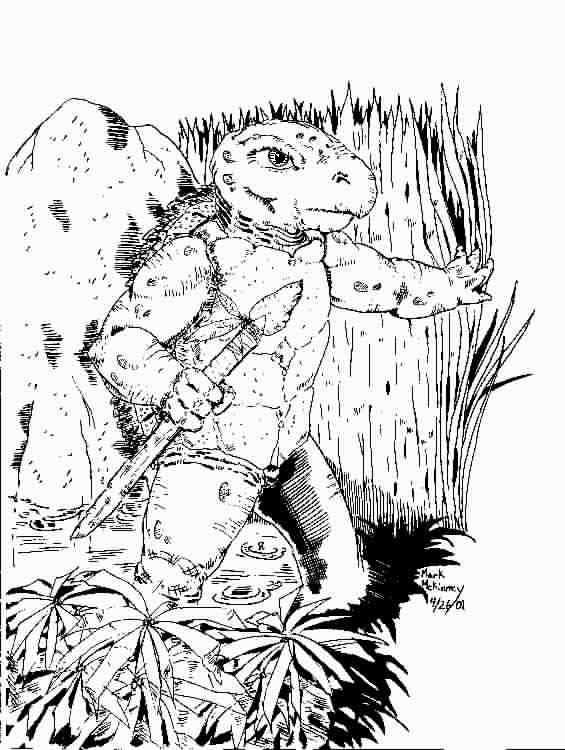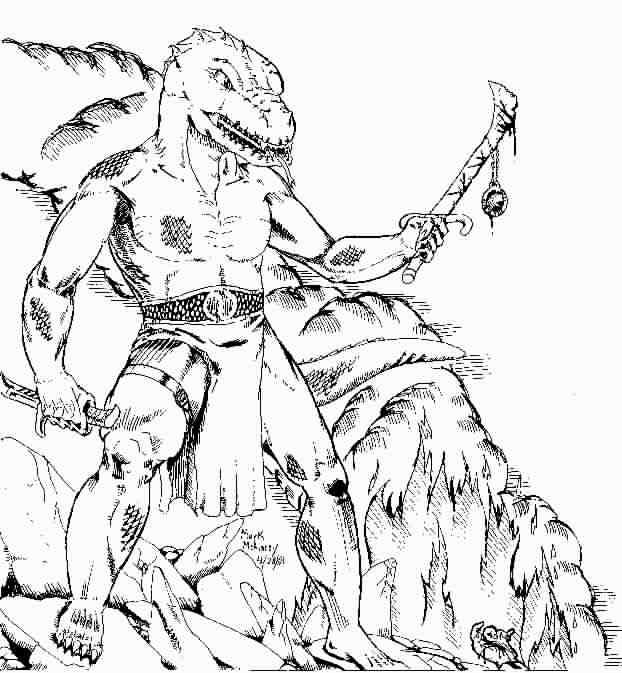
The Peoples of Mystara
Various intelligent beings live on-and in-Mystara. No almanac of the world could ever be complete without at least describing the major races that one can encounter during her travels. This section will therefore give a brief overview of the most important known intelligent species that have helped shape the history of Mystara. There are obviously more sentient races than those listed, but these are by far the more common.
By Dorrik Stonecleaver
Humans
Humans come in all shapes and sizes, without really any common theme to unite them. Historians claim that all the humans on Mystara are descendants from three ancient races of humans: the Neathar, Oltecs, and Tangor. A fourth major race, the Alphatians, arrived on our world just over 2,000 years ago, and has also contributed to the various cultures now found today. With such a short life span (compared to demihumans), humans have evolved rapidly and there are now more races of humans on Mystara than one can possibly keep track off.
Humans can be found on all the continents of Mystara, and seem to have adapted to almost any climate. As mentioned, there are too many races of humans to describe fully, but the two most common are the Thyatians with their olive complexion and dark hair as well as the Common Alphatians with coppery complexions and brown or red hair.
If there is anything that can be said to generalise humans is that they are all unique. Racial unity is rare, and only takes place when there is a non-human threat close by. Otherwise, they fight more often amongst themselves than with other races.
Dwarves

The dwarves of Mystara, often called Rockborn dwarves, all came from the same source: the mountains of Rockhome. They claim that Kagyar-their patron Immortal-created them circa BC 1800, and they have since spread throughout the continent of Brun. Some have even sailed across the sea and made their homes in the land of the now sunken continent of Alphatia [in the former nation of Stoutfellow. Ed.]. Whether the dwarves have colonised other continents during the past remains to be discovered.
Dwarves are lawful beings who only change their ways of life after a very, very long period of time. Every dwarven colony still speaks the exact same dialect of Dengar that is still used in Rockhome. The same holds true for their physical characteristics: all dwarves on Mystara are still identical to their racial ancestors. Rockborn Dwarves are the only race of dwarves that exist on the surface of Mystara.
Rockborn dwarves are stocky and muscular with a deep tan or light brown skin, often with ruddy cheeks. Their hair is often black, grey, or brown, with similar colours for their bright eyes. They vary in height between 4 and 41/2 feet. [AD&D2: Rockborn dwarves are considered to be the hill dwarves of Mystara, as described in the PHB and Complete Book of Dwarves.]
A second race of dwarves, the Kogolor dwarves, has been found in the Hollow World. There doesn't appear to be any connection between these dwarves and Rockborn dwarves. Their description is still unknown to the authors of this almanac.
Elves

The elves claim that they were born from the soul of Mystara and the Immortal Ordana several thousand years ago. At first, guardian spirits of the land watched over them, but then one day they were let free to inhabit the world of Mystara. Some sages speculate that the ancient elves were actually colonists from another world, much like the Alphatians. The departure of the "guardian spirits" is interpreted as a loss of contact with their homeworld. Elves scoff at this idea, however.
Five main races of elves exist on Mystara: the Aquarendi (aquatic elves), the ee'aar, the shadow elves, the Shiye elves, and the sylvan elves. Sages claim that all except the shadow elves evolved [or arrived, depending on the sage. Ed.] while the elves were still watched over by the "guardian spirits." In general, elves stand about 5 feet in height, are more slender than humans, and have pointed ears.
The most common race of elves encountered is that of the sylvan elves who are named after their legendary homeland, the Sylvan Realm. Sylvan elves have either pale blond hair and blue eyes, or dark hair and intense green eyes. A few clans have red hair, and grey is also not unheard of. Unlike all other elven races, sylvan elves can grow moustaches and beards, a trait that is often noticed on the elves of Belcadiz. Sylvan elves are scattered throughout the continents of Brun and Davania, and almost all the elven clans found in the Old World and the Savage Coast are sylvan elves. Sylvan elves prefer a simple life and live high up in the trees of many forests. Some clans have different attitudes, however. The Belcadiz of Glantri enjoy prestige, reputation and living in human-styled houses, while the Meditor and Verdier elves of Minrothad love money and are renowned sailors. The sylvan elves of the Savage Coast have actually abandoned all elven ways and adopted the lifestyles of the nations they live in. [AD&D2: Sylvan elves are considered to be the high elves of Mystara, as described in the PHB and Complete Book of Elves.]
The Aquarendi are an aquatic race of elves that inhabit the various seas of our world. Gill slits in their neck permit them to breathe while underwater. They have webs between their fingers and toes, and small fins on their ankles. Green and blue hair is common among the sea elves, although brown or black have been spotted on rare occasions. Skin colours range from light tan for those living near the shore to bright green or blue for those living deep beneath the sea. [AD&D2: Aquarendi are considered to be the sea elves of Mystara, as described in the PHB and Complete Book of Elves.]
The ee'aar are a rare race of winged elves that inhabit the western end of the Savage Coast and the Arm of the Immortals. They look much as the sylvan elves, except appear much more delicate and with more angular facial features. Of course, they also have large feathered wings with a wingspan of at least 10 feet. They usually have white or silver hair, although black and grey are not uncommon. Their wings are the same colour as their hair. Eyes tend to be amber, violet, or deep green. [AD&D2: Ee'aar are the avariel, or winged elves, of Mystara, as described in the Complete Book of Elves.]
The shadow elves are a mysterious race of underground elves. They have grey skin and white hair, and their philosophies appear to be much different than other elves'. To date, not much more is known about them. Shadow elves inhabit the nation of Aengmor in the Old World, and they also have a large empire deep beneath the ground. The nation of Schattenalfheim in the Hollow World is also composed of shadow elves. [There is no AD&D2 counterpart for the shadow elves. AD&D2 stats are given on TSR's homepage.]
Finally, the Shiye elves are slightly taller than other elves. When the elves left their ancient homeland, the Shiye elves went with the sylvan elves and helped create the Sylvan Realm. But the differences in philosophies, especially the Shiye's xenophobia, eventually caused them to leave. Their new migration brought them to the continent of Alphatia where they founded Shiye-Lawr, the largest nation of Shiye elves. They usually have silver hair and amber eyes, although a few rare Shiye elves have pale golden hair and violet eyes. They are more reclusive than sylvan elves, and live a much more ordered life than their chaotic cousins. Shiye elves are found throughout Alphatian territories such as Norwold and Bellissaria. Also, one colony of Shiye elves seems to have settled in Eusdria on the Savage Coast. [AD&D2: Shiye elves are considered to be the grey elves of Mystara, as described in the PHB and Complete Book of Elves.]
Gnomes
Like dwarves, gnomes claim they were created by their patron Immortal-Garal Glitterlode-who also placed them in the mountains of the area now known as Rockhome. Unlike the dwarves, however, gnomish colonisation of the rest of the world wasn't so successful. Only when they colonised areas with the dwarves [such as Highforge in Karameikos or Stoutfellow in Alphatia. Ed.] did their colonies survive. Seeing how they couldn't forge nations on the ground, the gnomes of Mystara built Serraine, their wondrous flying city, and there they remain to this day. Still, small scattered communities can still be found in the Old World and Norwold. Elsewhere, gnomes do not seem to be present, though rumours coming from the explorers of the southern continent would have them uncontested rulers in the farthest reaches of Davania.
Strictly speaking, there is only one race of gnomes present on Mystara, and they are simply known as Mystaran gnomes. The second "race" of gnomes is that of the sky gnomes which inhabit the flying city of Serraine. As such, physically the two races of gnomes are identical (hence the reference to just one race of gnomes), although their attitude and culture are so different that many sages prefer to separate them into two races.
Gnomes stand about 3 feet tall and have rather pronounced noses of which they are quite proud. They have either pale blond or red hair, which often turns white as they age. Their skin ranges from dark tan to woody brown, and they usually have bright blue eyes. [AD&D2: Mystaran gnomes are considered to be the rock gnomes of Mystara as described in the Complete Book of Gnomes and Halflings. Sky gnomes enjoy inventing things, and are similar to tinker gnomes, but have more common sense and less chances of exploding inventions. Serraine does fly, after all!]
Goblinoids
Goblinoids is a generic term used to describe various barbaric races seemingly related to goblins, and generally descended from the old Beastmen race that can still be encountered in the Hollow world. There are far too many types of goblinoids to describe here, and many volumes at the very least would be required. Suffice to say that the following goblinoid species are present on Mystara: bugbear, gnoll, goblin, half-ogre, half-orc, hobgoblin, kobold, ogre, orc, and troll. Of those mentioned above, kobolds seem limited to the Old World, while the rest can be found in all areas of Mystara, though only orcs and Beastmen can be found in the Hollow World.
Within each species of goblinoid there are several dozen to hundred of races. For example, in the Broken Lands, there are three races of orcs: yellow orcs, red orcs, and the Hyborean common orc. Several hundred other orc races exist outside the Broken Lands. [AD&D2: Stats for these goblinoids can be found in the Complete Book of Humanoids.]
Half-Elves
Half-elves are so rare in the Old World as to be almost legendary [in fact, if playing D&D, they don't exist at all. Ed.]. Many sages believe that a Mystaran elf/human couple somehow has a harder time at producing offspring than is reportedly possible on other worlds. When they do, the result is invariably a half-elf [or a human with elven blood or elf with human blood if playing a pure D&D game; see GAZ5 The Elves of Alfheim for more details. Ed.]. Strangely enough, half-elves are more common on the Savage Coast. Some speculate Immortal involvement, others a side effect of the Red Curse [two possible reasons for having half-elves on the Savage Coast in a pure D&D game. Ed.]. Half-elves are unknown in the rest of the world.
Half-elves appear like a mix between their human and elven ancestors, hence can have a large variety of appearances. A look through both the human and elven races can give an idea of the possibilities. Despite this, half-elves are considered to be of one race: half-elven [or half-human if you're talking to an elf. Ed.]. Unlike most other worlds, half-elves aren't treated with total scorn by the elves of Mystara; they are so rare that most are curious about half-elves and will gladly accept their company for a while just to learn more about them.
Hin (Halflings)
The hin, sometimes called halflings by other races, are a small folk who enjoy a good life. Hin have no knowledge of their creation or arrival, although historians trace them back to the original elven homeland, leading them to speculate they "appeared" [that is, were created or arrived from another world. Ed.] with the elves. Hin tend to blend in with the surrounding communities rather than create their own. Most hin are therefore found in human nations. The Five Shires of the Old World and the city-state of Leeha in Norwold are the only known true hin communities. On the Savage Coast, they have been completely absorbed into the local nations.
Hin rarely grow larger than 3 feet in height. They have ruddy complexions, sandy to dark-brown hair, and blue or hazel eyes. Their faces are small and childlike when compared to a human. Hin also have thick hair atop each foot. [AD&D2: Hin are considered to be the hairfoot halflings of Mystara, as described in the PHB and Complete Book of Gnomes and Halflings.]
Lupins

Lupins are a race of dog-people that have spread over the world of Mystara. The origins of the lupins are unclear; some believe they are merely a type of more civilised gnolls, and if this were the case, then gnolls would be a race of lupins and not goblinoids. Others think that they are the descendants of the Hutaakans, a race created by the Immortal Pflarr at some unknown period of history. Because of this belief, some lupins have returned to worshipping Pflarr, and this has caused much trouble in the lupin nation of Renardie.
Over the centuries, lupins have scattered over most of Brun and the rest of Mystara, evolving into several different races. Like humans and other short-lived species, there are too many races of lupins to mention here, just as there are far too many breeds of dogs to describe in a couple of paragraphs. I shall therefore limit this entry to naming a few and giving a general location where they can be found.
Grand bloodhounds are excellent trackers from the nation of Renardie, while the carrasquito is a small breed that lives in El Grande Carrascal of the Savage Coast. The ogrish chow-chow was once a slave race to the ogre-magi of Ochalea but is now free. The foxfolk is scattered throughout Brun, while the Glantri mountaineer is limited to the Glantrian Alps. The Heldann shepherds are a goat and sheep raising race found in the Heldannic Territories.
Many, many more exist, especially crossbreeds and mongrels (as they are called). For a more complete list and better descriptions, I strongly recommend an article written by Raman Nabonidus of the Princess Ark. The article is entitled Lupins of the Mystara setting and can be found in Dragon Magazine #237.
Rakasta

The rakasta are a race of cat-like beings that also claim that a patron Immortal created them. This time, it is the Immortal Ka who transformed a cat into a human when it fell in love with her master. But when Ba-steh [the human/cat in question. Ed.] still behaved like a cat, Ka instead transformed her and her human lover into cat-people: the first rakasta. When this happened is still unknown, but it is believed to have occurred prior to the Great Rain of Fire, explaining how they have since spread throughout most of the world [and even beyond if you believe they have a colony on an invisible moon. Ed.]. They have adapted to various climates and evolved into several sub-races.
Rakasta are mainly wild, and most have fled lands that were colonised by humans, and as such are almost unheard of in the Old World. Rakasta have one nation on the Savage Coast [Bellayne. Ed.], but beyond that are mostly scattered tribes throughout the world. Like all short-lived races (that is, those of less than 100 years), rakasta have evolved rapidly and many races now apparently exist in the wild, so below we'll only describe those who often come in contact with the rest of the civilised world. In general, rakasta are man-sized, but weight easily two or three times as much. One noticeable difference in the fact that rakasta need 12 hours of sleep per day.
The msongo, also known as the fast runners, have a coarse coat varying from yellowish-grey to golden. A reddish fawn with small dark spots is also common among them. They are tall and lanky, but can achieve great speeds when running. The msongo are known to inhabit the Meghala Kimata grasslands of Davania, the Steppes of Jen of Skothar, and on the Thothian Plateau on the Isle of Dawn.
The jakar are found in the rainforests of the Arm of the Immortals. They have beautiful spotted coats that are prized by Vilaverdan hunters. Not much is known about them except that most Vilaverdans hunting the jakar fail to return from their expeditions.
Mountain rakasta are the most common rakasta of the Savage Coast, and have also been spotted in the remote wilderness of Norwold. Their fur varies from plain brown-brown to reddish and even black. A tribe of mountain rakasta is rumoured to inhabit the Kurish Massif, and if this is true, they are the only known rakasta in the Old World.
Many other races of rakasta exist, and those seeking more information should look up the Rakasta of Mystara, written by Raman Nabonidus of the Princess Ark. [This article can be found in Dragon Magazine #247. Ed.]
Tortles

Tortles are a race of heavy, turtle-like humanoids who carry shells on their backs. They can be encountered throughout the Savage Coast, notably in or near the free city of Dunwick, and generally lead peaceful lives as farmers or workers.
Lizard Men

Lizard men are an ancient race of reptilian humanoids. They are rarely encountered in the Old
World, but tribes can be found just about anywhere on Mystara. They have a whole nation in the Hollow
World, in a region called the Malpheggi Swamp (not to be confused with the
Malpheggi Swamp lying within Darokin's borders).